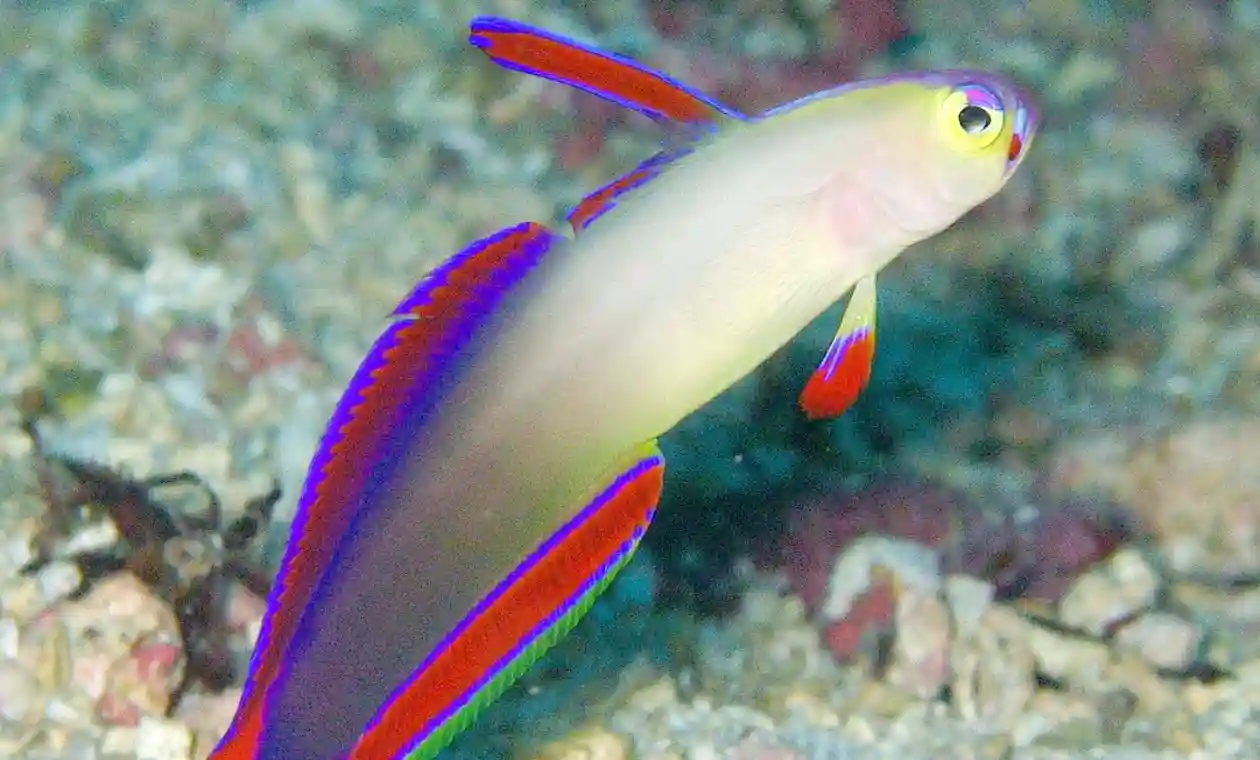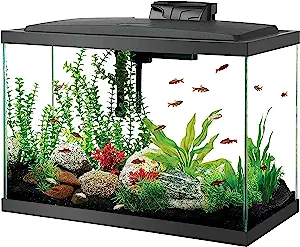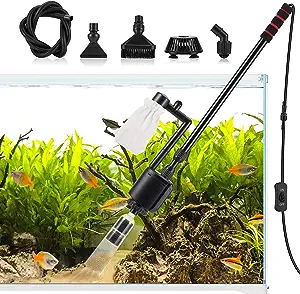A Beginner’s Guide to Firefish: Beauty and Grace in Your Aquarium”

Imagine a world of underwater wonder, where colors dance and elegance takes on a new form. In the realm of aquarium enthusiasts, few creatures evoke as much fascination and admiration as the Firefish. With their vibrant hues and graceful movements, Firefish have earned a cherished place in the hearts of aquarists worldwide.
In this article, we will embark on a journey into the aquatic universe of Firefish. These mesmerizing marine species have become stars of the aquarium hobby, enchanting beginners and seasoned enthusiasts alike. Join us as we dive into the depths of understanding Firefish, from their captivating appearance to the art of their care, and discover how these aquatic wonders can bring a touch of enchantment to your own aquatic oasis.
Getting to Know Firefish
To truly appreciate the allure of Firefish in aquariums, it’s essential to begin by understanding what these remarkable creatures are. Firefish, scientifically known as Nemateleotris spp., are a group of small, brightly colored marine fish belonging to the Gobiidae family. They are commonly referred to as “Firefish” due to their striking, fiery colors and graceful swimming behavior.
Appearance, Colors, and Distinctive Features
Firefish are renowned for their captivating appearance. They typically boast a slender, elongated body with a pointed snout and a dorsal fin that resembles a sail, which they can raise and lower at will. The vibrant colors of Firefish are a feast for the eyes, ranging from shades of red, orange, and yellow to stunning iridescent hues. One of their most distinctive features is their large, expressive eyes, which add to their overall charm.
Natural Habitat of Firefish in the Wild
Firefish originate from the tropical waters of the Indo-Pacific region. They are commonly found in coral-rich reef environments, where they seek refuge among the crevices and hiding spots provided by the coral formations. In the wild, Firefish thrive in warm, clear waters, making them a perfect fit for reef ecosystems.
Behavior in Their Native Environment
In their natural habitat, Firefish exhibit intriguing behaviors. They are known for their cautious and timid nature, often darting into hiding when they sense potential threats. Firefish prefer to spend their time hovering above the substrate or within the shelter of coral branches, using their pectoral fins to maintain their position in the water column. This behavior not only helps them evade predators but also makes them captivating to observe in an aquarium setting.
The Firefish Goby
The Firefish Goby, a close relative of the Firefish, is a beloved and common choice among aquarium enthusiasts. Known for its stunning appearance and engaging behavior, the Firefish Goby (Nemateleotris magnifica) has earned a special place in the hearts of aquarists. Let’s explore what makes this fish a standout in the world of aquarium keeping.
Unique Characteristics
One of the most striking features of the Firefish Goby is its vivid coloration. Sporting vibrant shades of red, orange, and purple, with intricate patterns on its body, it’s no wonder this species has earned the moniker “magnifica.” The Firefish Goby’s elongated dorsal fin resembles a sail, adding an elegant touch to its overall appearance.
But beauty isn’t the only thing that sets the Firefish Goby apart. These fish are renowned for their fascinating behavior. They are known to be both inquisitive and skittish, making them a captivating addition to any aquarium. Firefish Gobies are often seen darting in and out of hiding places, exploring their surroundings with a sense of curiosity that aquarium keepers find endearing.
Role in Reef Tanks
One of the primary reasons why Firefish Gobies are sought after by reef tank enthusiasts is their compatibility with coral and other reef inhabitants. These fish are considered reef-safe, meaning they won’t harm or disturb the corals and invertebrates in your tank. In fact, they often form symbiotic relationships with certain species of gobies and pistol shrimp, with the shrimp digging and maintaining a burrow that the Firefish Goby shares as a shelter.
Their presence adds not only visual appeal but also contributes to the overall health of a reef aquarium by assisting in the maintenance of a clean and balanced ecosystem. Their constant movement and vigilant behavior can even act as a kind of “canary in the coal mine,” as any changes in their behavior may indicate potential issues with water quality or the overall aquarium environment.
Essential Care Tips for Keeping Firefish in Aquariums
Caring for Firefish in your aquarium can be a rewarding experience, provided you meet their specific requirements. Here are some essential care tips to ensure the health and happiness of your Firefish:
Water Parameters, Temperature, and Salinity Requirements
- Temperature: Maintain the water temperature in the range of 74-78°F (23-26°C), as Firefish thrive in warm tropical waters.
- Salinity: Keep the salinity levels in your aquarium at around 1.023-1.025 specific gravity, which is typical for marine aquariums.
- pH Levels: Maintain a stable pH level between 8.1 and 8.4.
- Ammonia, Nitrite, and Nitrate: Regularly test and keep these levels at near-zero, as Firefish are sensitive to water quality.
- Alkalinity and Calcium: Monitor and adjust these parameters to support the health of corals and other reef inhabitants.
Tank Setup and Hiding Places
- Tank Size: A suitable tank size for Firefish is around 20-30 gallons or larger, providing ample swimming space.
- Live Rock: Include live rock in your aquarium to provide natural hiding spots and encourage the growth of beneficial microorganisms.
- Hiding Places: Firefish are known for their shy nature, so ensure there are plenty of hiding places like caves, crevices, and coral formations. PVC pipe sections can also serve as hiding spots.
Feeding Firefish and Maintaining a Balanced Diet
- Firefish are omnivores, meaning they consume both meaty and plant-based foods. Offer a varied diet that includes high-quality flake foods, pellets, frozen foods like brine shrimp and mysis shrimp, and even some live or frozen marine worms.
- Feed small, frequent meals rather than large quantities at once.
- Ensure that the food is appropriately sized for your Firefish to consume within a few minutes to prevent overfeeding and water quality issues.
Firefish Behavior
Firefish exhibit a fascinating array of behaviors that make them intriguing subjects for observation in your aquarium. Here, we’ll delve into the nuances of their behavior:
Temperament and Shyness:
- Firefish are known for their timid and cautious nature. They tend to dart into hiding spots when they perceive potential threats, making them somewhat skittish.
- Their shy behavior is often attributed to their survival instincts in the wild, where hiding among coral formations helps protect them from predators.
Swimming Patterns:
- Firefish are excellent swimmers, gracefully navigating the water column with ease. Their elongated dorsal fin, resembling a sail, adds to their elegance as they move.
- You’ll often see them hovering above the substrate or swimming near live rock, where they feel most secure.
Compatibility with Other Fish Species:
- Firefish are generally considered peaceful and can coexist with a variety of reef-safe fish species. However, avoid housing them with aggressive or predatory fish that may intimidate or harm them.
- They are known to form symbiotic relationships with certain gobies and pistol shrimp, sharing burrows as hiding spots in the aquarium.
Remarkable Behaviors and Habits:
- Firefish have a distinctive and captivating display behavior. When they feel threatened or during courtship, they will “dart” upwards in the water column, displaying their vibrant colors and elongated dorsal fin.
- Observing this display is a memorable experience and a sign of a healthy and content Firefish in your aquarium.
- Firefish are often active during the day, making them a delightful addition to a well-lit aquarium where their colors can truly shine.
Creating the Perfect Firefish Aquarium
Creating an ideal aquarium environment for Firefish requires careful planning and attention to detail. Here’s a step-by-step guide to help you set up the perfect Firefish-friendly aquarium:
Step 1: Tank Size


- Choose an aquarium with a capacity of at least 20-30 gallons to provide enough space for your Firefish to swim comfortably.
- Larger tanks offer more stability in terms of water parameters and make it easier to maintain the required conditions.
Step 2: Water Parameters and Quality
- Maintain stable water parameters, including a temperature range of 74-78°F (23-26°C) and a specific gravity of 1.023-1.025.
- Regularly test and maintain appropriate pH, ammonia, nitrite, and nitrate levels.
- Use a high-quality protein skimmer and a reliable filtration system to ensure excellent water quality.
Step 3: Tank Decorations and Hiding Places
- Incorporate live rock into your aquarium to provide hiding spots, create natural habitats, and promote the growth of beneficial microorganisms.
- Ensure there are plenty of caves, crevices, and coral formations where Firefish can retreat and feel secure.
- PVC pipe sections can serve as additional hiding spots.
Step 4: Lighting


- Provide moderate to high-intensity lighting, as Firefish thrive in well-lit environments.
- Mimic natural daylight to enhance the visibility of their vibrant colors.
Step 5: Tank Mates
- Firefish are generally peaceful but somewhat shy. Choose tank mates that are compatible and won’t intimidate them.
- Consider other reef-safe fish species like gobies, clownfish, and peaceful wrasses.
- Avoid housing Firefish with aggressive or predatory fish that may harass or harm them.
Step 6: Feeding and Diet
- Offer a varied diet that includes high-quality flake foods, pellets, frozen foods like brine shrimp and mysis shrimp, and occasional live or frozen marine worms.
- Feed small, frequent meals to prevent overfeeding and maintain water quality.
Step 7: Maintenance and Monitoring


- Regularly perform water changes to maintain stable water conditions and remove accumulated waste.
- Monitor your Firefish for signs of stress, illness, or behavioral changes, and take prompt action if needed.
Different Firefish Species
Firefish encompass several distinct species, each with its unique characteristics and care requirements. Here, we’ll provide an overview of some notable Firefish species, including the Purple Firefish and the Magnificent Firefish:
1. Purple Firefish (Nemateleotris decora):
- Overview: The Purple Firefish, as its name suggests, boasts stunning shades of purple and red, making it a captivating addition to aquariums.
- Unique Characteristics: This species is known for its vibrant colors and an elongated dorsal fin, which adds an element of grace to its appearance.
- Care Requirements: Purple Firefish have similar care requirements to other Firefish species. They thrive in stable water conditions and benefit from a well-established reef environment with hiding spots and suitable tank mates.
2. Magnificent Firefish (Nemateleotris magnifica):
- Overview: The Magnificent Firefish lives up to its name with its dazzling colors, predominantly red with yellow and purple accents.
- Unique Characteristics: One of the distinct features of the Magnificent Firefish is its bright yellow face and ventral fins, which contrast beautifully with its red body.
- Care Requirements: This species shares care requirements with other Firefish. It’s essential to provide a spacious tank with hiding spots, stable water parameters, and a diet consisting of varied, high-quality foods.
3. Other Firefish Species:
- In addition to the Purple Firefish and Magnificent Firefish, there are other species within the Nemateleotris genus, such as the Exquisite Firefish (Nemateleotris exquisita) and the Decorated Firefish (Nemateleotris magnificus).
- These species may have variations in coloration and patterns but generally share similar care requirements and temperaments.
The Firefish Diet
Understanding the dietary preferences of Firefish is crucial to maintaining their health and vibrancy in your aquarium. In this section, we’ll explore what Firefish eat in their natural habitat and provide guidance on offering a balanced diet in captivity.
What Firefish Eat in Their Natural Habitat:
In their native habitat on coral reefs, Firefish primarily feed on a diet that includes:
- Zooplankton: Small aquatic animals such as tiny crustaceans, copepods, and amphipods are a significant part of their diet. Firefish are skilled hunters and use their keen eyesight to spot and catch these small prey items.
- Algae: While zooplankton makes up the majority of their diet, Firefish also graze on algae and other small plant materials present on the reef. This plant matter provides them with essential nutrients.
- Microorganisms: They consume microorganisms and tiny invertebrates found in and around coral formations, benefiting from the complex and diverse ecosystem of the reef.
Offering a Balanced Diet in Captivity:
To replicate the Firefish’s natural diet in captivity, consider the following guidelines:
- High-Quality Flake and Pellet Foods: Start with a base diet of high-quality flake and pellet foods designed for marine fish. Look for those with a well-balanced nutritional profile.
- Frozen Foods: Supplement their diet with frozen foods such as brine shrimp, mysis shrimp, and daphnia. These foods mimic the small, protein-rich prey items they would hunt in the wild.
- Live Foods: Occasionally, offer live foods like copepods and amphipods to stimulate their natural hunting instincts. Live foods can be a special treat for Firefish.
- Herbivore Foods: Firefish also graze on algae, so consider providing herbivore-specific foods designed for marine herbivores. These foods help satisfy their need for plant matter in their diet.
Feeding Schedule:
- Feed small, frequent meals throughout the day rather than one large meal. Firefish have small stomachs and are more likely to consume all the food offered without overeating.
- Feed them a variety of foods to ensure a balanced diet and prevent dietary deficiencies.
Observation and Adjustment:
- Monitor your Firefish during feeding to ensure they are actively consuming food.
- Adjust the feeding schedule and types of food offered based on their preferences and behavior.
Firefish Reproduction
Firefish are known for their intriguing reproductive behaviors, making them an exciting species to observe and potentially breed in aquariums. In this section, we will detail the reproduction and breeding habits of Firefish in aquariums and offer guidance on creating breeding conditions if desired.
Reproduction and Breeding Habits:
Firefish engage in a unique and mesmerizing courtship and mating ritual that often starts with the male performing a spectacular display. Here are the key steps in Firefish reproduction:
- Courtship Display: The male Firefish initiates courtship by performing a striking display. He rises in the water column, displaying his vibrant colors and extending his dorsal fin. This display is designed to attract a female.
- Female’s Choice: If a female is interested in the male’s display, she may respond by engaging in a synchronized swimming pattern with the male.
- Egg Laying: Once courtship is successful, the female will release her eggs into the water column. The male then fertilizes the eggs by releasing sperm.
- Floating Eggs: Firefish eggs are buoyant and float in the water column. The male and female typically do not provide any parental care, and the eggs are left to drift freely.
- Hatching and Larval Stage: After a period of time, the eggs hatch into larvae. The larvae are incredibly small and require specialized care and feeding to survive.
- Challenges of Raising Larvae: Rearing Firefish larvae can be a complex and challenging endeavor due to their small size and specific dietary needs. It often involves providing tiny live foods and maintaining stable water conditions.
Guidance on Creating Breeding Conditions:
If you are interested in breeding Firefish in your aquarium, consider the following steps:
- Pairing: To encourage breeding, keep a well-matched pair of Firefish in a spacious aquarium with plenty of hiding spots.
- Provide Proper Nutrition: Ensure that both the male and female Firefish are well-fed and in excellent health.
- Simulate Dawn and Dusk: Some aquarists have found success in triggering breeding behavior by simulating dawn and dusk using aquarium lighting controls. This can mimic the natural light cycles that Firefish experience on coral reefs.
- Prepare for Larval Stage: Be prepared to care for and feed the tiny larvae that result from successful breeding. Research the specific dietary requirements and have appropriate live foods ready.
- Patience: Breeding Firefish can be a long and challenging process, and success is not guaranteed. Patience and dedication are essential.
Firefish Venom and Safety
Firefish are renowned for their beauty and grace, but they also possess a hidden defense mechanism – venomous spines. In this section, we’ll inform readers about the venomous spines of Firefish and provide essential guidance on how to handle Firefish safely to avoid injury.
Venomous Spines of Firefish:
Firefish have dorsal spines that are equipped with venomous glands. These spines are primarily a defensive adaptation to deter predators in their natural habitat. When threatened or agitated, Firefish can erect these spines, making them a formidable opponent.
The venom produced by Firefish is not typically life-threatening to humans, but it can cause intense pain, swelling, and other unpleasant symptoms. It’s crucial to exercise caution when handling Firefish to prevent injury.
Handling Firefish Safely:
Here are some tips for safely handling Firefish in your aquarium:
- Use Tools: When necessary, use a net or a container to handle Firefish rather than your bare hands. This prevents accidental stings.
- Avoid Agitation: Minimize stress and agitation when interacting with Firefish. Sudden movements or attempts to capture them can trigger their defensive response.
- Wear Gloves: If you need to handle Firefish directly, wear gloves made of a sturdy material to protect your hands from potential stings.
- Be Gentle: Handle Firefish gently and avoid squeezing or applying excessive pressure, as this can cause the venom to be injected.
- Emergency Protocol: In case of a sting, rinse the affected area with warm water and seek medical attention if symptoms are severe or allergic reactions occur. Applying hot water (at a temperature as hot as can be tolerated) to the sting site may help alleviate pain.
- Observation: Be cautious when introducing new decorations or rearranging the aquarium, as Firefish may feel threatened and use their spines in response.
Firefish Conservation
As of my last knowledge update in September 2021, Firefish (Nemateleotris spp.) are generally not assessed individually for their conservation status. However, they are part of the broader ecosystem of coral reefs, which face significant threats worldwide. Coral reefs are essential habitats for many marine species, including Firefish, and are invaluable for maintaining marine biodiversity.
Coral reefs are under threat from various factors, including:
- Coral Bleaching: Rising sea temperatures due to climate change can cause coral bleaching events, which harm the coral and the entire reef ecosystem.
- Ocean Acidification: Increased carbon dioxide in the atmosphere leads to ocean acidification, which can affect the ability of corals to build their calcium carbonate skeletons.
- Overfishing: Overfishing can disrupt the balance of reef ecosystems by removing key species that maintain their health.
- Habitat Destruction: Human activities such as coastal development and pollution can directly harm coral reefs and the species that depend on them.
Conservation Efforts:
While Firefish are not targeted by specific conservation efforts, protecting their natural habitat and the broader coral reef ecosystem is crucial for their well-being. Conservation efforts that benefit Firefish and coral reefs include:
- Marine Protected Areas: The establishment of marine protected areas (MPAs) helps safeguard critical reef habitats and allows them to recover from various threats.
- Climate Change Mitigation: Reducing greenhouse gas emissions to combat climate change is essential for preventing coral bleaching events and ocean acidification.
- Sustainable Fishing Practices: Promoting sustainable fishing practices helps maintain the balance of reef ecosystems and prevent overfishing.
- Coral Reef Restoration: Efforts to restore damaged coral reefs, such as coral planting and restoration projects, contribute to the recovery of reef ecosystems.
How Readers Can Contribute:
Readers interested in contributing to Firefish and coral reef conservation can take several actions:
- Support Conservation Organizations: Contribute to and support organizations dedicated to coral reef conservation, such as The Nature Conservancy or the Coral Reef Alliance.
- Practice Sustainable Seafood Consumption: Choose sustainably sourced seafood products to reduce the demand for unsustainable fishing practices.
- Reduce Carbon Footprint: Reduce your carbon footprint by using energy-efficient appliances, minimizing energy consumption, and supporting renewable energy sources.
- Participate in Reef Cleanup Initiatives: Join local beach and reef cleanup initiatives to help reduce pollution in marine environments.
- Educate Others: Raise awareness about the importance of coral reefs and marine conservation by educating friends and family.
Conclusion:
In the depths of our aquariums, the Firefish swim as living jewels, captivating our senses with their vibrant colors and graceful movements. Throughout this journey, we’ve explored the enchanting world of Firefish, from their alluring appearance to the intricacies of their care and behavior.
We’ve learned that Firefish, with their timid yet inquisitive nature, can thrive in aquariums that replicate their natural habitat. Creating the perfect environment, with ample hiding spots among live rock and compatible tank mates, ensures their well-being.
Understanding their dietary preferences, we’ve discovered the art of providing a balanced diet, enriching their lives while maintaining their health. The possibility of breeding Firefish adds an exciting dimension to their presence in our aquariums.
Yet, as we admire these aquatic wonders, we must also respect their self-defense mechanisms. The venomous spines, while not deadly to humans, remind us of the importance of responsible handling.
Furthermore, Firefish beckon us to consider their conservation. As part of the intricate tapestry of coral reef ecosystems, they rely on the health of these habitats. Coral reefs, a haven for biodiversity, face threats that require our collective action and support for conservation efforts.
FireFish FAQ
How do you identify different Firefish species?
Different Firefish species can be identified by their unique coloration and patterns. For example, the Purple Firefish has shades of purple and red, while the Magnificent Firefish features bright yellow on its face and fins.
Are firefish suitable for beginners in the aquarium hobby?
Yes, Firefish can be suitable for beginners as they are generally hardy and have manageable care requirements. However, it's essential to research and provide the right environment and care.
What size tank is best for keeping firefish?
A tank size of at least 20-30 gallons is recommended for keeping Firefish. Larger tanks offer more stability and room for them to swim comfortably.
What should I feed my firefish in an aquarium?
Firefish should be fed a varied diet that includes high-quality flake and pellet foods, frozen foods like brine shrimp, and occasional live or frozen marine worms.
Are firefish reef-safe?
Yes, Firefish are generally considered reef-safe. They coexist well with corals and other reef inhabitants. However, they may nip at small, delicate polyps, so monitor their behavior.
How do firefish reproduce in captivity?
Firefish reproduce through a courtship and mating ritual. The male displays vibrant colors and erects its dorsal fin to attract the female. The female releases eggs into the water, and the male fertilizes them. Larvae hatch and require specialized care.
Can firefish be kept with other fish in the same tank?
Yes, Firefish are generally peaceful and can be kept with other reef-safe fish species like gobies, clownfish, and peaceful wrasses. Avoid aggressive or predatory fish that may harass them.
What are the venomous spines of firefish, and how dangerous are they?
Firefish have dorsal spines with venomous glands. While the venom is not typically life-threatening to humans, it can cause intense pain, swelling, and discomfort if stung. Handle them with care.
Are firefish endangered in the wild?
Firefish species were not individually assessed for their conservation status. However, they are part of the broader ecosystem of coral reefs, which face significant threats. Supporting coral reef conservation efforts helps protect Firefish and their habitats.
